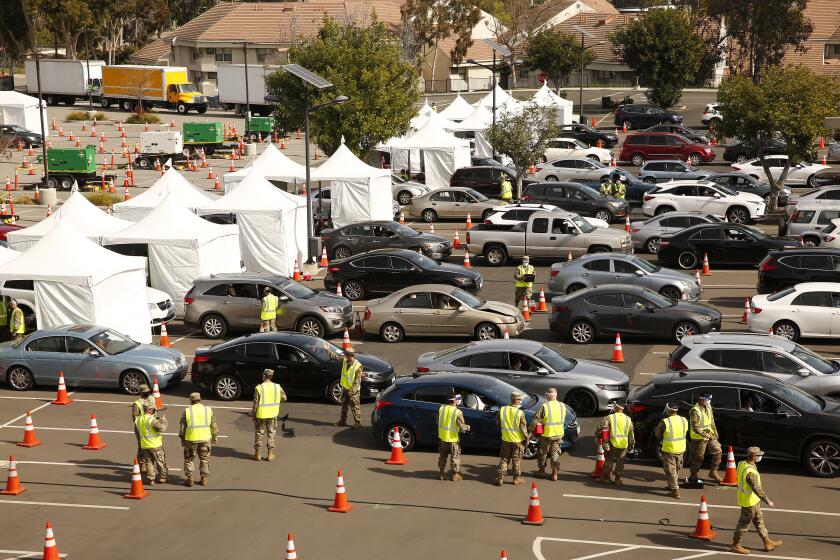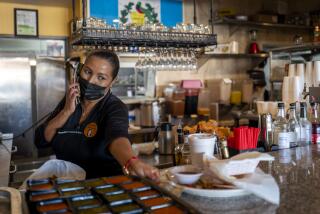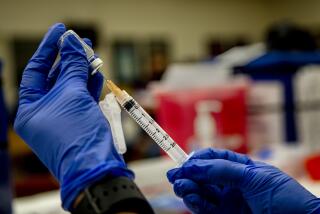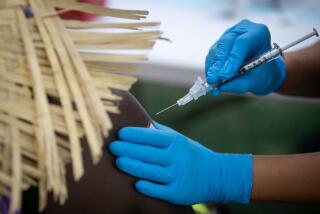California will reserve 40% of COVID-19 vaccine for disadvantaged areas to speed reopenings

- Share via
SAN FRANCISCO — In a major shift in policy, California officials said Wednesday night they will now devote 40% of available COVID-19 vaccines to residents in the most disadvantaged areas in a move designed to both slow the spread of coronavirus and speed up the reopening of the economy.
After roughly another 400,000 doses are administered to people who live in California’s hardest hit communities — which could happen within the next two weeks — officials in Gov. Gavin Newsom’s administration said the state intends to significantly relax the rules for counties to exit the most restrictive tier of California’s coronavirus reopening blueprint.
The shift comes amid mounting evidence that Latino and Black communities are falling behind white and Asian ones in getting access to the vaccine. This has sparked concern in part because those underserved communities have been hardest hit by COVID-19. They are home to many essential workers, who have contracted the virus on the job and then spread it at home.
But the move adds yet another shift in the state’s rocky vaccine rollout, which has been marked by big shortages of supply. It comes at a time when more people are becoming eligible for immunizations.
In a few weeks, the state will expand eligibility to millions of people with underlying health problems and disabilities. With large amounts of vaccine now reserved, there will be less to go around to other groups. Officials are hoping for major boosts in vaccine supply in the coming weeks.
Newsom himself foreshadowed the concept during a briefing in Long Beach early Wednesday afternoon, though he did not offer specifics at that time.
“We want to incorporate vaccination rates into the tiering, and that will allow people to move more quickly through the tiers,” he said.
Currently, 1.6 million COVID-19 vaccine doses have been administered to individuals who live in the state’s hardest-hit communities — specifically, those in the lowest quartile of the California Healthy Places index, a measure of socioeconomic opportunity that takes into account economic, social, education, housing and transportation factors.
Once 2 million doses have been administered in these communities, the state will relax the threshold by which a county can exit the most restrictive purple category of the state’s four-tier, color-coded reopening plan. In that category, indoor operations are forbidden or severely limited at many businesses and public spaces, including restaurant dining rooms, gyms, museums, zoos and aquariums.
In Southern California, targeted communities would include South Los Angeles, the Eastside, Koreatown, Chinatown, Compton, southeast L.A. County, the eastern San Fernando Valley, Santa Ana, and a number of heavily Latino communities along the Interstate 10 corridor between Pomona and San Bernardino.
Administration officials said that quartile consists of roughly 400 different ZIP codes sprinkled throughout the state, though many of them are in the Central Valley and in and around Los Angeles County.
Counties’ tier assignments are based on three criteria: average daily case rates, adjusted based on the number of tests performed; the testing positivity rate; and a health equity metric intended to ensure that the positivity rate in poorer communities is not significantly worse than the county’s overall figure.
Currently, counties generally must have an adjusted daily coronavirus case rate at or below 7.0 new cases per day per 100,000 people to move from the purple tier to the more permissive red tier.
After the state achieves its 2-million dose goal, however, counties with a case rate of up to 10 new cases per day per 100,000 people will become eligible for the red tier.
The change in policy stands to accelerate the movement for many Southern California counties, allowing them to broadly reopen their economies sooner. Under the new proposed rules, L.A., Orange and San Bernardino counties would already be eligible to exit the purple tier, while Riverside, Ventura and San Diego counties would also be close to qualifying.
Per 100,000 residents, L.A. County currently has an adjusted daily case rate of 7.2; Orange, 7.6; Riverside, 11.3; San Bernardino, 9; San Diego, 10.8 and Ventura, 10.6.
Once a total of 4 million doses are administered to these lower-income communities, state officials will also relax the thresholds for entering the subsequent tiers, the orange and yellow tiers. However, they did not specify what those new thresholds would be.
The orange tier would allow sports fans to return to outdoor professional sports venues and allow indoor family entertainment centers like bowling alleys and escape rooms to reopen; the yellow tier allows large theme parks to reopen.
“Even with these steps, we will still have some of the strongest public health protections … in the nation,” said one Newsom administration official.
The problem isn’t the order in which people can book their appointments online. It’s the fact that people have to get online at all.
Administration officials confirmed that the state’s previously announced dedicated dose share for educators — 10% of California’s weekly allotment — will remain in place.
Providers throughout California have administered more than 9.4 million total COVID-19 vaccine doses to date. Though the state has worked to ramp up how quickly available shots are going into arms, tens of millions of residents are still waiting for their turn in line.
Along with promoting equity in the state’s vaccine rollout, the administration officials said the plan discussed Wednesday is pragmatic. Vaccinating those most at risk of being victims or vectors of the coronavirus will help stymie its spread. Plus, vaccinating significant numbers of people better armors the wider community against widespread transmission — meaning the thresholds to more widely reopen businesses and public spaces no longer will need to be as strict.
Though she said she wasn’t privy to the specifics of the proposal, Los Angeles County Public Health Director Barbara Ferrer said Wednesday afternoon that she thinks it would make sense for vaccinations to play some kind of role in guiding the reopening process.
“Once you are vaccinating millions and millions of people, you need to take that into account as you determine the safety of a variety of activities,” she said during a briefing Wednesday. “I think that’s completely appropriate. I mean, we said that all along: vaccines are, in fact, a game changer. But you have to have lots and lots of people getting vaccinated before it’s going to make a big difference.”
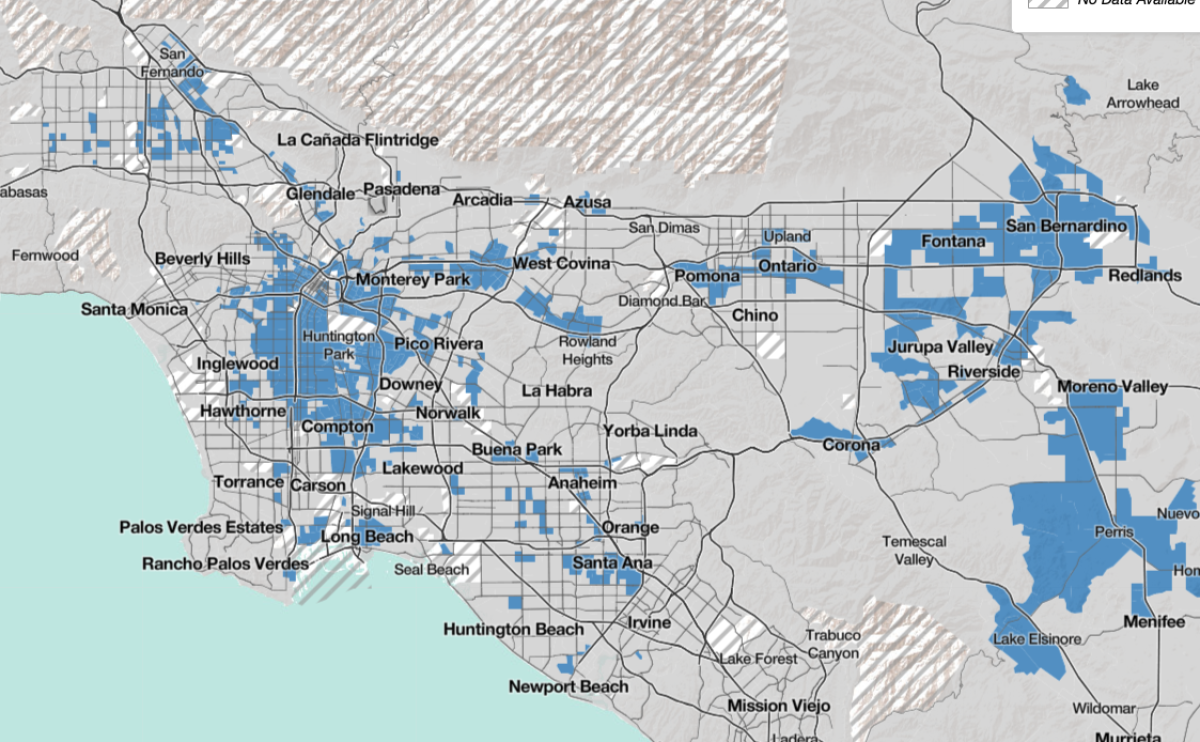
Lin reported from San Francisco; Money from Long Beach.
More to Read
Sign up for Essential California
The most important California stories and recommendations in your inbox every morning.
You may occasionally receive promotional content from the Los Angeles Times.
